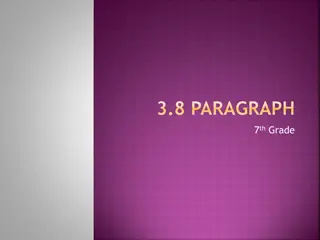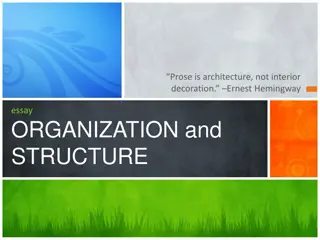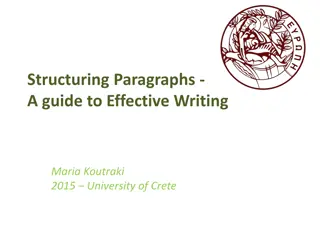Understanding Paragraph Organization in Historical Prose Writing
Explore the D-N-A structure of paragraph organization in historical prose writing, focusing on transitional words, revision strategies, and the inseparable connection between history and writing. Learn how to develop effective paragraphs that guide the reader through your historical narrative.
Download Presentation

Please find below an Image/Link to download the presentation.
The content on the website is provided AS IS for your information and personal use only. It may not be sold, licensed, or shared on other websites without obtaining consent from the author. Download presentation by click this link. If you encounter any issues during the download, it is possible that the publisher has removed the file from their server.
E N D
Presentation Transcript
Writing History A Presentation of the UNA Center for Writing Excellence for HI 301W: History & Historical Research Dr. Robert T. Koch Jr. Dr. Tom Osborne March 4, 2009
Goals Understand the D-N-A structure of paragraph organization in historical prose writing. Understand the function and construction of paragraphs within the D-N-A structure. Become familiar with transitional words that signify turns of thought within the D-N-A structure. Become familiar with revision/rewriting strategies as tools for shaping your historical prose.
The Premise History and writing are inseparable. We cannot know history well unless we write about it. 1
The Modern Rhetorical Triangle2 Writer Text/Subject Reader
D-N-A Paragraph Structure Description Analysis Narration
D-N-A Through the Essay Introduction / D-N-A Sequence D-N-A Sequence / Conclusion D-N-A Sequence D-N-A Sequence Repeat the sequence as often as you need to get from the Introduction and Thesis to the Conclusion!
Description ON WEDNESDAY, the 29th of April, at four in the afternoon it would have been pleasant in the gardens of Charles V's old hunting lodge at Aranjuez. In all the high plateau of New Castile there is no place like Aranjuez for flowers and there is no season at Aranjuez like the beginning of May. Usually Philip passed the month there. Only when he was making himself king of Portugal had he missed spending May at Aranjuez. Then he had written wistfully of the flowers and the nightingales in its gardens. This year he had hurried thither as soon as he could decently leave Madrid. In springtime the late afternoon sun was kindest to his gout, and this was the time of day Philip visited his flowers. While he lingered among them a dispatch came from Paris. Don Bernardino de Mendoza wrote that on April 12th Drake had sailed from Plymouth with some thirty ships. His mission was almost certainly to hinder the assembling of the Spanish fleet, and his first target would probably be Cadiz. Perhaps the king stayed longer than usual that day in his garden; perhaps his gout sent him earlier than usual to bed. Whatever the reason he did not read Mendoza's alarming dispatch until the next morning. It was too late, anyway. 3
Description Strategies Provide context What is the historical situation you are showing to your reader? Use factual information. What must your reader know to understand the narrative? Develop setting: What is the place and time? Be specific, but show it, don t tell it. Appeal to the senses: Sight, smell, hear, touch, and taste but factual! Strong Ex. The ornamented tree filled the room with a pine scent on this cold, wintery evening. Weak Ex. It was a cold December night.
Narration Later on the same day that Pedro de Valdes surrendered, Monday, August 1st, the English picked up a second prize. About noon the master of the San Salvador sent word that she was slowly sinking. The explosion which had wrecked her afterdecks had started too many seams and water was rising in the well faster than the pumps could handle. Her crew were taken off, and some of her stores, but oddly enough not the powder and great shot in her forward hold, and she was let drift astern. She should have been scuttled, but either somebody failed to get the word, or the English came up too fast. Lord Howard himself went aboard her, but made a very brief inspection; the stench of burnt corpses was too much for him. Later Captain Fleming, commander of the pinnace which brought the first news of the Armada, managed to tow the waterlogged hulk into Weymouth. The news of the two prizes raised all spirits on shore. The first day's battle off the Eddystone had been clearly seen by crowds of watchers on the land, but it had been hard to tell whether things went well or ill. 4
Narrative Strategies What does this narrative do to bring your descriptive scene to life? Who are the characters? What are they doing? What action is essential to the story? Consider the key issues in a narrative: Plot Inciting incident (the cause of the action) Rising action (leading your reader to a climactic moment) Climax (the point in the story where the tensions and issues comes to a head for the main character) Denouement (falling action, or how the tension is resolved)
Analysis The bitter lesson for the Spanish was that even when they had the weather gauge they could not grapple and board the English ships, which were fast enough and weatherly enough to keep whatever distance they chose. The Spanish all thought that the enemy seemed to be right, t00, in trusting to their guns, for the English had more big guns and of longer range, and better gunners who could fire much faster. Everyone in both fleets said three times as fast, though it must have been hard to keep count. The bitter lesson for the English was that, in the face of Spanish discipline, their chosen tactics were not working. They had not expected to sink many of the Spanish fleet at the first encounter, or the second, but they had expected to cripple the galleons one by one so that they would have to drop out of formation and be overwhelmed. 5
Analysis Strategies What does this narrative mean for your audience? Use your rhetorical modes/patterns of thought Definition, Comparison & Contrast, Problem & Solution, Cause & Effect, Classification, Division, Illustration What lessons do participants in the narrative learn from their experiences? What other options or possibilities might have existed for the participants? Why were or weren t these realistic choices?
Note-taking: Asking Questions6 Who? (Characters) What? (Plot, Relationships, Qualities, Patterns) When? (Why then? When is information known?) Where? (Why there?) Why? (Cause and Effect)
Note-taking: Summarizing7 Read the text once, asking questions about how paragraphs relate, or why the author would include certain specific pieces of information. At the end of the first read, identify the main point (thesis) of the work (usually found at the start or end of the introduction or the start or end of the conclusion) Read again, a few paragraphs or a section at a time, taking notes on the chronological main points, key facts, and key transitions of each paragraph as you read.8 Close the source or put it away. Without looking at the source or your notes, write down the main point and the key sub-points or arguments in the text. 1. 2. 3. 4. 5.
Signpost or Transitional Words9 Description Place, Direction: over , under, above, below, inside, outside, next to, left, right, in front of, behind, beyond, in the distance1 Senses: saw, smelled, tasted, felt, heard Narrative Chronology: now, after, then, finally, at last, sooner, later, meanwhile, simultaneously, in the meantime, in the past, prior to this, before
Signpost or Transitional Words Analysis Cause & Effect: because, consequently, so, therefore, thus, as a result, hence Compare: similarly, likewise Contrast: but, however, except, yet, nevertheless, conversely, although Addition: and, besides, in addition, also, too, moreover, furthermore, next, finally, last, likewise, similarly Process or Importance: first, second, third, etc.
Notes Richard Marius and Melvin E. Page, A Short Guide to Writing About History, 6th ed. (New York: Pearson Longman, 2007), 4. Bruce Ballenger, The Curious Writer (New York: Pearson Longman, 2005), 11-12. Garrett Mattingly, The Armada (Boston: Houghton Mifflin, 1959), 93. Ibid., 296. Ibid., 300. Marius and Page, Short Guide, 33-9. Muriel Harris, The Prentice Hall Reference Guide for Professional Writing (Upper Saddle River, NJ: Pearson Prentice Hall, 2007), 442. Marius and Page, Short Guide, 112. Harris, Reference Guide, 185-6. 1. 2. 3. 4. 5. 6. 7. 8. 9.
Bibliography Ballenger, Bruce. The Curious Writer. New York: Pearson Longman, 2005. Harris, Muriel. The Prentice Hall Reference Guide for Professional Writing. Upper Saddle River, NJ: Pearson Prentice Hall, 2007. Marius, Richard and Melvin E. Page. A Short Guide to Writing About History, 6th ed. New York: Pearson Longman, 2007. Mattingly, Garrett. The Armada. Boston: Houghton Mifflin, 1959.























